The Morgan Library
By Lucas Compan
In 1924 J. P. Morgan, Jr. gave his father's extraordinary library to the public. The most influential financier in this country's history, Pierpont Morgan was also a voracious collector. He bought on an astonishing scale, collecting art objects in virtually every medium, including the rare books, manuscripts, drawings, prints, and ancient artifacts that are the core of The Morgan Library & Museum's holdings.
Image: courtesy morgan library
The Morgan houses art in virtually every medium, including drawings, prints, and artifacts dating from 4000 B.C. to the twenty-first century. The library's holdings include a host of rare books and manuscripts: one of 23 copies of the original Declaration of Independence; Mozart's handwritten score of the Haffner Symphony; the collected works of Phillis Wheatley, the first known African-American poet; the only extant manuscript of Milton's Paradise Lost; and Charles Dickens’s manuscript of A Christmas Carol.
The Morgan houses art in virtually every medium, including drawings, prints, and artifacts dating from 4000 B.C. to the twenty-first century. The library's holdings include a host of rare books and manuscripts: one of 23 copies of the original Declaration of Independence; Mozart's handwritten score of the Haffner Symphony; the collected works of Phillis Wheatley, the first known African-American poet; the only extant manuscript of Milton's Paradise Lost; and Charles Dickens’s manuscript of A Christmas Carol. Image: courtesy morgan library
The Morgan offers a free hourlong “highlights” tour of the permanent collection Tuesday through Sunday at 12:30 p.m. If a particular exhibition interests you, check the tour schedule to time your visit.
The Morgan offers a free hourlong “highlights” tour of the permanent collection Tuesday through Sunday at 12:30 p.m. If a particular exhibition interests you, check the tour schedule to time your visit. Image: courtesy morgan library
Even if you don’t feel like buying items related to the collections, the Morgan Shop is worth visiting, since it’s located in J.P. Morgan Jr.'s former brownstone.
Even if you don’t feel like buying items related to the collections, the Morgan Shop is worth visiting, since it’s located in J.P. Morgan Jr.'s former brownstone. Image: courtesy morgan library
Pierpont Morgan's immense holdings ranged from Egyptian art to Renaissance paintings to Chinese porcelains. For his library, Morgan acquired illuminated, literary, and historical manuscripts, early printed books, and old master drawings and prints. To this core collection, he added the earliest evidence of writing as manifested in ancient seals, tablets, and papyrus fragments from Egypt and the Near East. Morgan also collected manuscripts and printed materials significant to American history.
Pierpont Morgan's immense holdings ranged from Egyptian art to Renaissance paintings to Chinese porcelains. For his library, Morgan acquired illuminated, literary, and historical manuscripts, early printed books, and old master drawings and prints. To this core collection, he added the earliest evidence of writing as manifested in ancient seals, tablets, and papyrus fragments from Egypt and the Near East. Morgan also collected manuscripts and printed materials significant to American history. Image: courtesy morgan library
Over the years—through purchases and generous gifts—the Morgan has continued to actively acquire rare materials as well as important music manuscripts, a fine collection of early children's books and manuscripts, and materials from the twentieth century (as well as earlier periods). Nevertheless the focus on the written word, the history of the book, and master drawings has been maintained.
Over the years—through purchases and generous gifts—the Morgan has continued to actively acquire rare materials as well as important music manuscripts, a fine collection of early children's books and manuscripts, and materials from the twentieth century (as well as earlier periods). Nevertheless the focus on the written word, the history of the book, and master drawings has been maintained. Image: courtesy morgan library
Related stories
More stories
Categories
- art 41
- bars 7
- bronx 1
- brooklyn 34
- carousel 3
- cars 2
- culture 45
- filmmaking 76
- food 29
- history 72
- holidays 14
- italy 19
- kids 46
- kids1 45
- landmarks 73
- lists 90
- manhattan 80
- music 1
- new york 145
- parks 9
- personal stories 29
- photography 79
- queens 29
- sculpture 3
- staten island 9
- summer 5
- the bronx 4
- things to do 111
- top secrets 81
- tours 110
- train 2
- waterfront 2
Explore using tags
- agostina cois
- attractions
- bars
- brooklyn
- central park
- decades tour
- filmmaking
- food
- food tours
- grand central terminal
- history
- intriguing new york series
- kids
- lists
- lucas compan
- new york city
- personal stories
- photography
- piccola new yorker
- queens
- stories of new york
- storytelling
- the high line
- things to do
- timelapse
- top secrets
- tours










